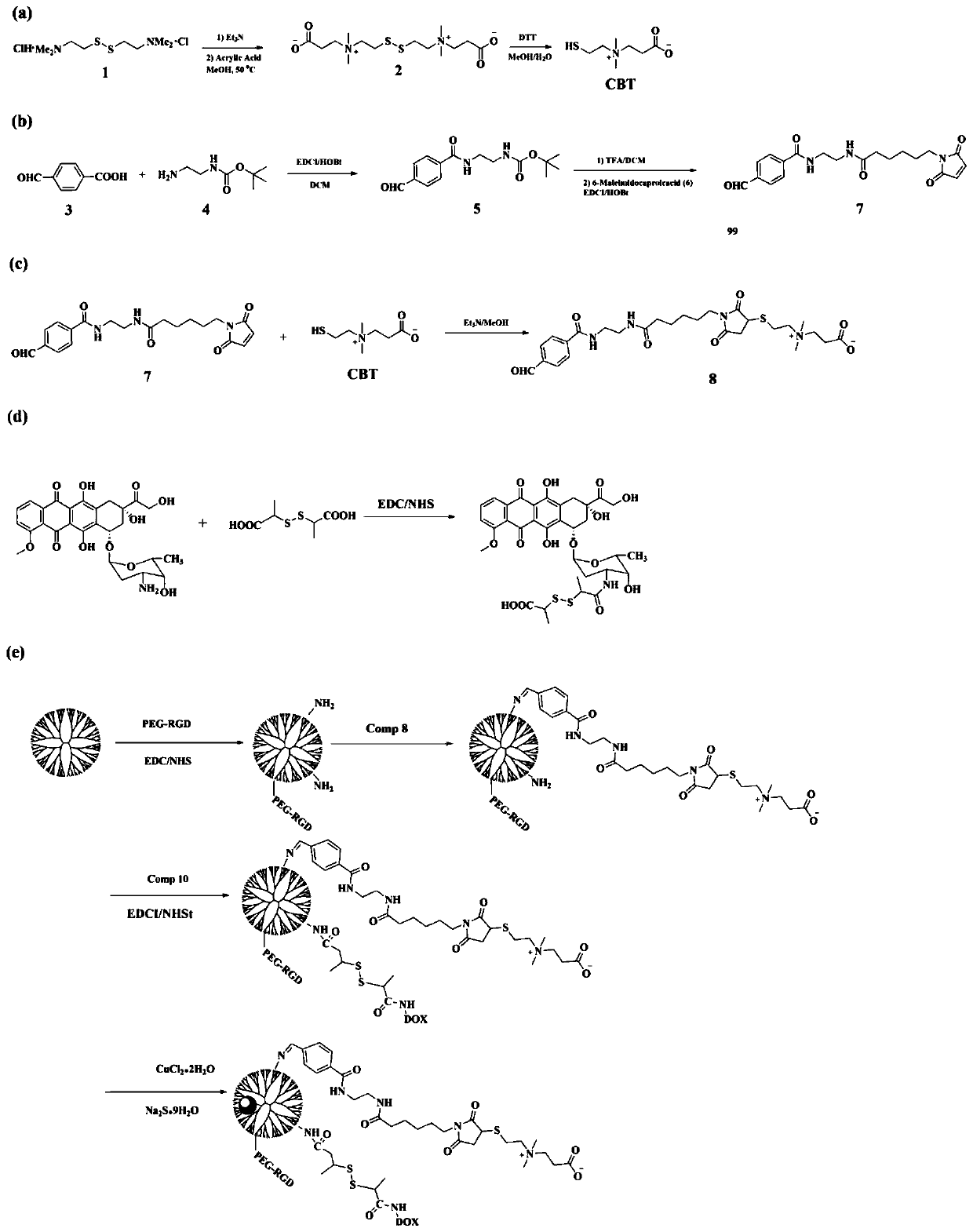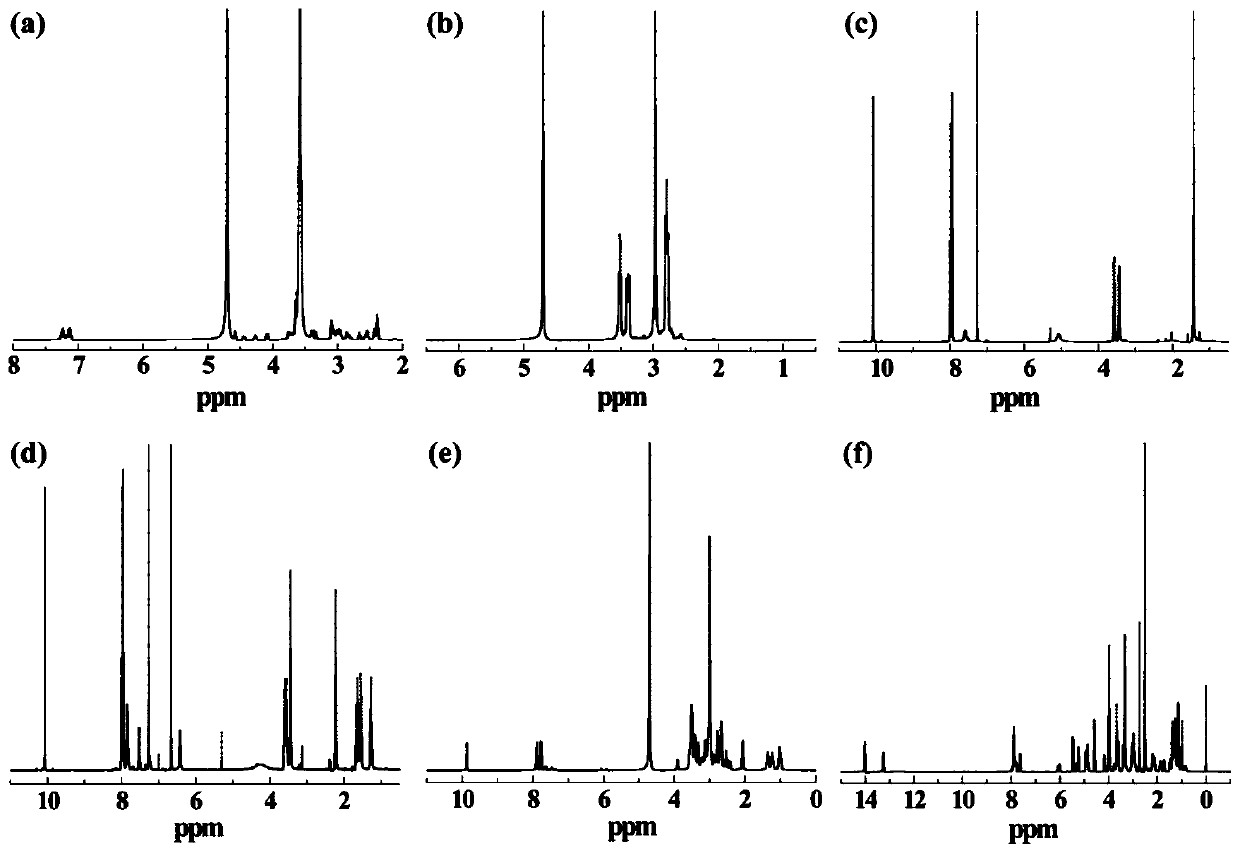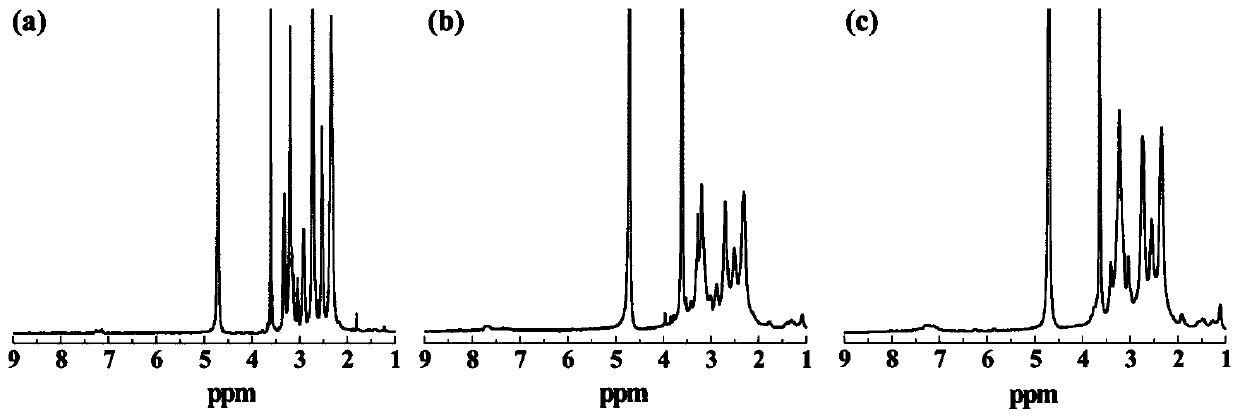Preparation method of RGD-modified dendrimer-encapsulated CuS nanoparticles
A technology of dendritic macromolecules and nanoparticles, which can be applied to the preparation method of peptides, medical preparations containing non-active ingredients, and medical preparations containing active ingredients. Water-soluble, promotes phagocytosis, and inhibits tumor growth
- Summary
- Abstract
- Description
- Claims
- Application Information
AI Technical Summary
Problems solved by technology
Method used
Image
Examples
Embodiment 1
[0053] (1) Dissolve 20mg of COOH-PEG-6-M in 5mL of DMSO, then add 6.91mg of RGD fully dissolved in 2mL of DMSO dropwise into the DMSO solution of COOH-PEG-6-M, and stir for 1 day , dialyzed for three days with a dialysis bag with a molecular weight cut-off of 1000, and then freeze-dried to obtain COOH-PEG-RGD. The COOH-PEG-RGD that gets 5mg synthesis is dissolved in deuterated water and carries out nuclear magnetic resonance analysis (1H NMR) (see figure 2 a). It can be seen from the figure that the spectral peaks at 7.3 and 7.4ppm prove that RGD is successfully connected to PEG, and it can be seen from the peak area integration that 0.7 RGD is connected to each PEG.
[0054] (2) Dissolve bis(2-dimethylaminoethyl) disulfide dihydrochloride (compound 1) (10.1g, 35.9mmol) and triethylamine (10.0mL, 71.7mmol) in anhydrous methanol (100mL ), the mixture was stirred at room temperature for 30 min. Then acrylic acid (48.3mL, 710mmol) and hydroquinone (500mg, 4.54mmol) were added...
Embodiment 2
[0060] (1) Mix and dissolve 13.75mg COOH-PEG-RGD, 8.16mg EDC and 4.80mg NHS prepared in Example 1 in 5mLDMSO, stir and activate for 3.5h, then add the mixed solution dropwise to G5.NH 2 DMSO solution (20 mg, 5 mL), stirred for 2 to 4 days, dialyzed and freeze-dried to obtain G5.NH 2 -PEG-RGD. Take 5 mg of prepared G5.NH 2 -PEG-RGD was dissolved in deuterated water for nuclear magnetic resonance analysis (1H NMR) (see image 3 a) and by integrating the peak area, it can be known that the average of each G5.NH 2 5.3 PEG-RGD were connected on.
[0061] (2) Take the CBT containing benzaldehyde terminal prepared in Example 1 and fully dissolve it in methanol solvent (22 mg, 5 mL), and then add it dropwise to G5.NH 2 - PEG-RGD methanol solution (52mg, 10mL) stirred at room temperature for 2-4h, dialyzed and freeze-dried to obtain G5.NH 2 -PEG-RGD-CBT. Take 5 mg of prepared G5.NH 2 -PEG-RGD-CBT dissolved in deuterated water for nuclear magnetic resonance analysis (1H NMR) (see...
Embodiment 3
[0065] Get the G5.NH prepared in Example 2 2 -PEG-RGD, G5.NH 2 -PEG-RGD-CBT, G5.NH 2 - PEG-RGD-CBT-DOX, {(CuS)-G5.NHAc-PEG-RGD-CBT-DOX} and G5.NH 2 Dissolve 1mg in 2mL aqueous solution, ultrasonically homogenize, measure UV absorption (see Figure 4 ). The UV results showed that DOX was successfully connected to the dendrimer, and the absorption peak was around 500nm, which was somewhat shifted compared with the absorption peak at 480nm of pure DOX. The formed CuS has a strong near-infrared absorption, and the absorption value becomes stronger and stronger with the extension of the wavelength, until the highest measurement limit of 1100nm, which also fully demonstrates the successful synthesis of CuS nanoparticles.
[0066] Dissolve the {(CuS)-G5.NHAc-PEG-RGD-CBT-DOX} prepared in Example 2 in 1 mL of ultrapure water (1 mg), then drop 5 μL of the nanoparticle suspension on the surface of the copper grid, Air-dried for TEM testing (see Figure 5 a). The high-resolution TE...
PUM
| Property | Measurement | Unit |
|---|---|---|
| diameter | aaaaa | aaaaa |
Abstract
Description
Claims
Application Information
 Login to View More
Login to View More - R&D
- Intellectual Property
- Life Sciences
- Materials
- Tech Scout
- Unparalleled Data Quality
- Higher Quality Content
- 60% Fewer Hallucinations
Browse by: Latest US Patents, China's latest patents, Technical Efficacy Thesaurus, Application Domain, Technology Topic, Popular Technical Reports.
© 2025 PatSnap. All rights reserved.Legal|Privacy policy|Modern Slavery Act Transparency Statement|Sitemap|About US| Contact US: help@patsnap.com



